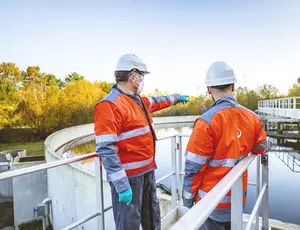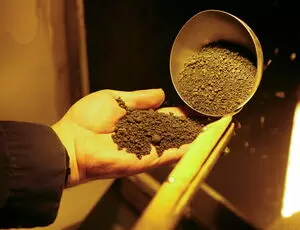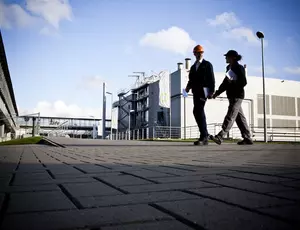An anaerobic membrane bioreactor (AnMBR) designed for industrial wastewater treatment purposes. It optimizes the generation of biogas, a local sustainable energy resource, while concurrently yielding high-quality effluent suitable for onsite reuse or direct discharge into the sewerage network.
Overview
Memthane® is an anaerobic membrane bioreactor (AnMBR) for industrial wastewater treatment that can be used in food and beverage facilities where biological treatment can be applied, from distilleries to dairies, instant coffee to bio-ethanol plants. The combined system maximizes the production of biogas, a local source of renewable energy while producing high-quality effluent that can be reused or discharged directly and safely to the sewerage network.
Memthane combines an ultrafiltration membrane separation system with a biological anaerobic digestion wastewater treatment process.
By using Memthane, operators can be assured that the AnMBR’s physical separation membranes, used in conjunction with anaerobic digestion, will remove the maximum amount of biomass while delivering the highest volume of biogas for industrial wastewater treatment customers.
How Memthane works
In the first stage of the treatment process, the ultrafiltration membranes help minimize surplus sludge production by ensuring long sludge retention times. To control bacterial concentrations throughout the industrial wastewater treatment system the sludge then enters the fully enclosed and easily maintained stand-alone anaerobic treatment system, which prevents odor release.
This leading-edge anaerobic digestion technology, developed by Biothane® — a Veolia Water Technologies' subsidiary— delivers a unique, small-footprint solution that offers multiple benefits, reducing biomass disposal costs while also generating valuable biogas.
Memthane also offers significant anaerobic digestion operating cost reduction for industrial wastewater treatment compared to conventional ultrafiltration membrane technologies in areas including chemicals, sludge and biomass disposal, and overall energy savings.
This simple, fully automated, anaerobic membrane bioreactor system for industrial wastewater treatment also has a remote control option.

Closing the loop on sustainability
The Memthane AnMBR can make a valuable contribution to achieving a circular economy of resources within a production facility. The methane-rich biogas produced from the anaerobic digestion process can cover up to 100% of a plant’s own energy and heat demand, while recovered nutrients from the biomass can be used for fertilizers, creating a potential revenue stream.
Water from the treated effluent can be reused onsite, closing the loop on resources and reducing water taken from municipal supplies. Not only can this reduce running costs, it can reduce operational risks in regions of water scarcity.
Due to Memthane AnMBR’s favorable investment and operating costs, along with its ease of use, it is increasingly being chosen by clients as their preferred industrial wastewater treatment solution.

Memthane provides a world of advantages for anaerobic digestion
- Rapid return on investment
- Robust and reliable treatment
- Superb effluent water quality for reuse
- Easy operation
- Low operational cost
- Easy recovery of nutrients for reuse
- Energy recovery through biogas reuse
- Avoids biogas scrubbing
- Minimizes sludge disposal costs
- Reduces environmental footprint
- Odor-free operon
Applications
Services
Our comprehensive service offering encompasses the refurbishment and reengineering of installations, ensuring that your systems and infrastructure are optimized for peak performance. We also specialize in planned service and preventive maintenance, proactively addressing potential issues to minimize downtime and costly repairs.
Contact
Memthane is a game-changing solution in the field of industrial wastewater treatment. Its anaerobic membrane bioreactor technology offers unparalleled efficiency and effectiveness in removing contaminants from various industrial wastewater streams. With its innovative design and advanced membrane filtration system, Memthane sets a new standard for sustainable and cost-effective wastewater treatment solutions.

Mathilde Baudry
Process Manager
Contact Mathilde through her LinkedIn account
FAQ about Memthane
What is anaerobic biological treatment?
Anaerobic biological treatment is a proven and energy-efficient method to convert industrial wastewater into biogas. Low energy requirements, a smaller reactor footprint, lower chemical usage, and reduced sludge handling costs are among the technology’s advantages.
Biogas produced through anaerobic treatment can make a plant energy-neutral or even a renewable energy producer.
What is ultrafiltration membrane separation?
Ultrafiltration is a membrane separation process used in various industries and applications to separate and purify industrial wastewater during the industrial wastewater treatment process.
Ultrafiltration membrane separation uses a semi-permeable membrane to separate particles and solids based on size and molecular weight. It is particularly effective in the removal of suspended solids, colloids, macro-molecules and microorganisms in the industrial wastewater treatment process.
What is a membrane?
The core component of ultrafiltration is a semi-permeable membrane. These membranes have a defined pore size, typically in the range of 0.001 to 0.1 micrometers. The pore size is chosen depending on the application and the desired separation characteristics.
Case Studies

Arla Foods required advanced industrial wastewater treatment and water recycling facilities for their new £150 million dairy in Aylesbury. The fresh milk processing facility processes one billion liters of milk annually. Arla wanted to create the first zero-carbon fresh milk processing facility in the world and Veolia provided the technology.

Jack Link’s, a leading protein snack producer, needed a water treatment solution at its facility located in Alpena (South Dakota) to reduce the fats, oils, and grease, and total suspended solids in wastewater. Veolia Water Technologies supported Jack Link’s by supplying Memthane®, a process that solves the issue of high biological oxygen demand (BOD) discharge from the facility, while simultaneously creating biogas as a by-product to reduce the plant’s energy costs.







